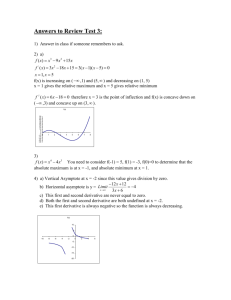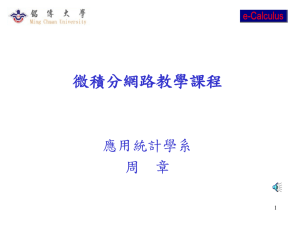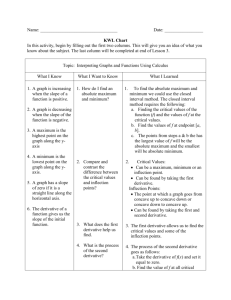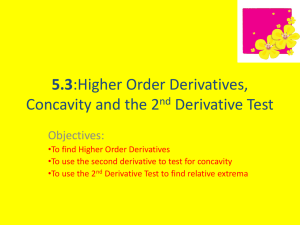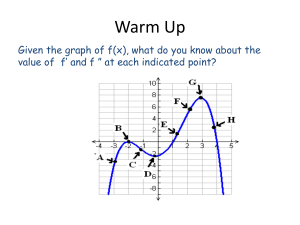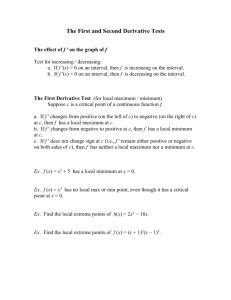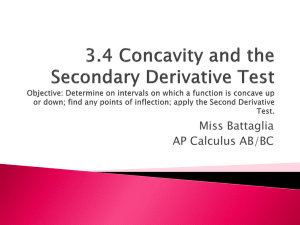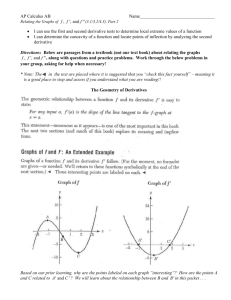File
advertisement
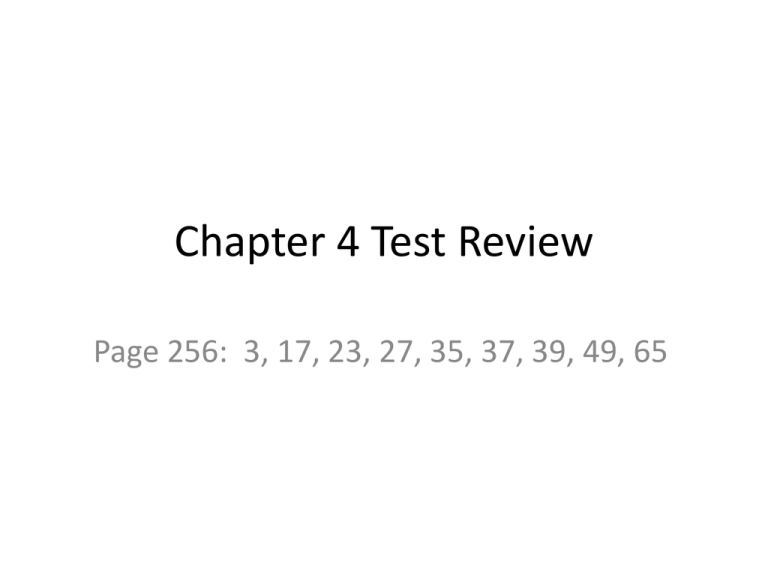
Chapter 4 Test Review Page 256: 3, 17, 23, 27, 35, 37, 39, 49, 65 Find the intervals on which the function is (a) increasing, (b) decreasing, (c) concave up, (d) concave down. Then find any (e) local extreme values, and (f) inflection points. 3. y x e 2 1 x2 2 x 2 yx e dy 2 x 2 3 x 2 x e 2 x e 2 x dx dy x 2 e x 2 2 x 3 2 x dx dy x 2 e 2 x 1 2 x dx Critical values: Where does the dy derivative equal zero, or where is 1 x 2 2 2 x e 1 x the derivative undefined? dx x 0 or x 1 or x 1 Find the intervals on which the function is (a) increasing, (b) decreasing, (c) concave up, (d) concave down. Then find any (e) local extreme values, and (f) inflection points. 3. y x 2 e dy 1 x 2 2 x e 1 x 2 dx 1 x2 x 0 or x 1 or x 1 y y' Dec 0 Inc 1 0 Dec 0 0 Inc 1 0 a 1, 0 1, b , 1 0, 1 e Local(andabsolute)minimaat 1, e and 1, e Find the intervals on which the function is (a) increasing, (b) decreasing, (c) concave up, (d) concave down. Then find any (e) local extreme values, and (f) inflection points. 1 x2 3. y x e dy 1 x 2 c , 0 0, 2 x e 1 x 2 dx d No where dy x 2 1 e 2x 2x dx f None d2y x 2 2 1 x 2 3 e 2 2 x 2 x 2 x e 2 x dx2 d2y x 2 2 2 4 y e 2 2 x 4 x 4 x Up Up 2 dx d2y x 2 2 4 0 0 2 e 1 x 2 x 0 y' ' dx2 2 Critical at x 0 Use the derivative of the function y = f (x) to find the point at which f has a (a) local maximum, (b) local minimum, or (c) point of inflection. 17. y' 6x 1x 2 Critical values: Where does the derivative equal zero, or where is the derivative undefined? 2 x 1 or x 2 y Dec y' 0 Inc 1 0 Inc 2 0 (a) No local maximum (b) Local maximum (and absolute) minimum at x = –1. Use the derivative of the function y = f (x) to find the point at which f has a (a) local maximum, (b) local minimum, or (c) point of inflection. 17. y' 6x 1x 2 2 y' ' 6x 1 2x 21 x 2 6 y' ' 18xx 2 y Up Up Down 2 y' ' 0 0 0 2 0 (c) Points of Inflection at x = 0 and x = 2 Find the function with the given derivative whose graph passes through the point P. 23. f ' x sin x cos x, P , 3 f x cos x sin x C f cos sin C 3 cos sin C 3 1 0 C 2C f x cos x sin x 2 Find the linearization L(x) of f (x) at x = a. 27. f x tan x, a f ' x sec2 x 4 2 f ' sec 2 4 4 f tan 1 4 4 Lx 2 x 1 4 Lx 2 x 1 4 L x 2 x 1 2 35. Connecting f and f ’ The graph of f ‘ is shown in Exercise 33. Sketch a possible graph of f given that it is continuous with domain [–3, 2] and f(–3) = 0. 37. Mean Value Theorem Let f (x) = x lnx. (a) The function is continuous on the interval [0.5, 3] and differentiable over (0.5, 3). (b) 1 f ' x x ln x 1 x f ' x 1 ln x f b f a f ' c ba f 3 f 0.5 f ' c 3 0. 5 3 ln 3 0.5ln0.5 1 ln c 2.5 37. Mean Value Theorem 3 ln 3 0.5ln0.5 1 ln c 2.5 ln c 27 27 ln 2 ln 54 2 2 ln1 2 2 22 2 1 ln c ln c 1 1 55 5 2 c ln 3 ln0.5 2.5 0.5 3 1 0.4 ln 27 2 1 0.4ln27 2 1 e c 1.579 37. Mean Value Theorem (c) Secant line AB A a, f a 0.5, ln0.5 B b, f b 3, ln 3 ln 3 ln0.5 1.457 m 3 0. 5 y ln 3 1.457x 3 y 1.457x 1.075 37. Mean Value Theorem (d) Tangent line parallel to AB c, f c 1.579, ln1.579 y ln1.579 1.457x 1.579 y 1.457x 1.579 39. Approximating Functions Let f be a function with f’ (x) = sin x2 and f (0) = –1. (a) Find the linearization of f at x = 0. f ' 0 sin 02 0 Lx 0x 0 1 Lx 1 (b) Approximate the value of f at x = 0.1. f 0.1 L0.1 1 39. Approximating Functions Let f be a function with f’ (x) = sin x2 and f (0) = –1. (c) Is the actual value of f at x = 0.1 greater than or less than the approximation in (b)? Greater than the approximation since f ’(x) is actually positive over the interval (0, 0.1) and the estimate is based on the derivative being 0. 49. Inscribing a Cylinder Find the height and radius of the largest right circular cylinder that can be put into a sphere of radius 3 as shown. 2 r V r h h2 V 3 h 4 h3 V 3h 4 dV 3h 2 3 dh 4 2 2 2 h 3 2 2 h r2 3 4 3h 3 0 4 3h 2 3 4 2 2 dV 3h 4 h 2 dh 2 2h 2 h 3 r 2 h 2 r 3 4 22 r 3 4 r 2 65. Estimating Change Write a formula that estimates the change that occurs in the volume of a right circular cone when the radius changes from a to a + dr and the height does not change. dV 2 rh dr 3 2 dV rh dr 3 h r 1 V r 2h 3 When the radius changes from a to a + dr, the volume change is approximately 2 dV ah dr . 3

